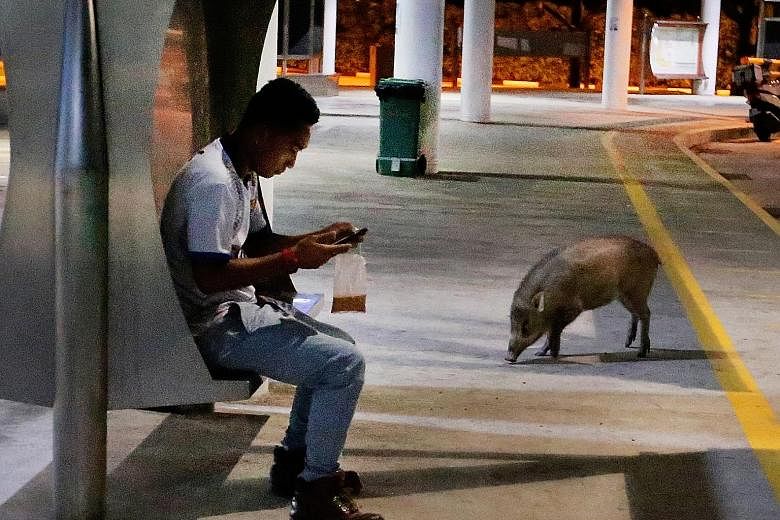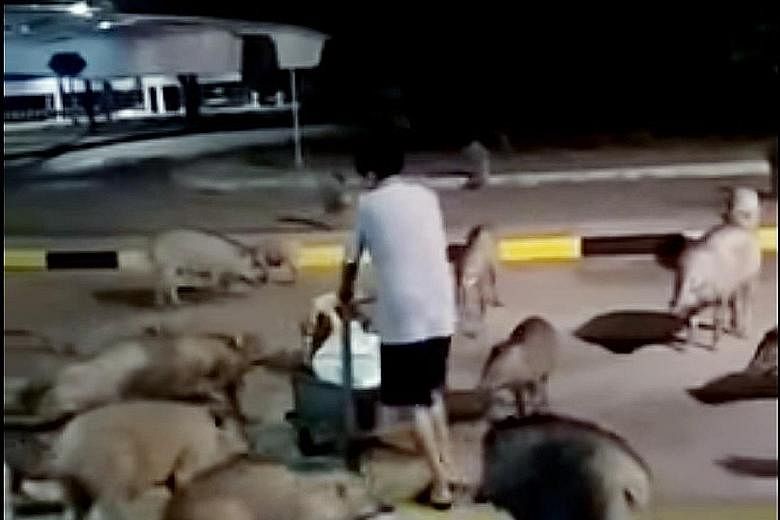Posters reading "No Feeding of Wild Animals" were put up by staff members around Tuas Bus Terminal and outside its canteen just before noon yesterday, after a video showing a pack of wild boars loitering in the area was shared online.
Those wild boars, said the Agri-Food and Veterinary Authority of Singapore (AVA), were likely used to being fed by people.
It, however, discouraged the public from doing so. "We strongly urge the public not to feed the boars as this alters their behaviour and may cause them to be reliant on humans for food, which may result in human-animal conflicts," it said.
In the viral video that has been circulating online, more than 15 of the animals are seen on the roads within the terminal and trotting in front of the canteen.
According to Mr Kalai Balakrishnan, deputy chief executive of Animal Concerns Research and Education Society, wild animals are usually shy, but the behaviour seen in the video points to the high probability that feeding is happening.
Ms Tammy Tan, senior vice- president of corporate communications at SBS Transit, said it was "monitoring the situation and working with the authorities". Putting up signs was one of the measures implemented by the transport company, she added, without elaborating on other measures.
The boars are not a new occurrence, according to people who spoke to The Straits Times during a visit to the terminal yesterday morning. Sightings were made as far back as four years ago.
-
When faced with a boar...
•Stay calm and move slowly away. Do not approach or attempt to feed the boar.
•Do not corner or provoke the boar.
•Avoid using a flash when taking photos of boars as this could startle or provoke them.
•If you see adult boars with their young, leave them alone. These boars are potentially more dangerous because they might attempt to defend their young.
•If approached by a boar, do not run away, hit it or make loud noises.
•Ensure that bins are covered and secured, to discourage boars from going to urban areas in search of food.
SOURCES: AVA AND ACRES
Most of them said that the wild boars would emerge from a small forested area beside the bus terminal, usually after 7pm in the evening till before 5am the next morning.
Vendors at the canteen, which is run by the National Transport Workers' Union, said they have not noticed the wild boars as the canteen operates from 7am to 3pm daily, and is closed on Sundays.
Mr Chia Chuan Chee, 46, a machine operator, saw a wild boar yesterday morning. "I see them quite often, but they will just be walking on the road without disturbing anyone."
Mr Mikhail Adam, 58, a bus captain, said: "Sometimes when the garbage bin spills, they will look for food there."
Wildlife consultant Subaraj Rajathurai also said that sightings of wild boars in Tuas are "normal" as there is a "good population over western Singapore".
According to wildlife experts, it is unclear if seeing a group consisting of more than 15 pigs is a sign of overpopulation, as natural population sizes in Singapore are not known.
Mr Kalai said that it is normal for boars to travel in herds and that the large group in the video is "not one of concern".
Across the island, from January to last month, the AVA received about 100 wild boar-related instances of feedback, compared with about 140 for the whole of last year, and about 80 for 2015.
The availability of food due to feeding might contribute to the wild boars breeding even more, said Mr Kalai.
In its statement, the AVA said it was working with the relevant agencies to monitor the situation and explore further measures.
Mr Kalai said: "Humane methods, like sterilising the boars or stopping the feeding, should be explored to handle the issue."


